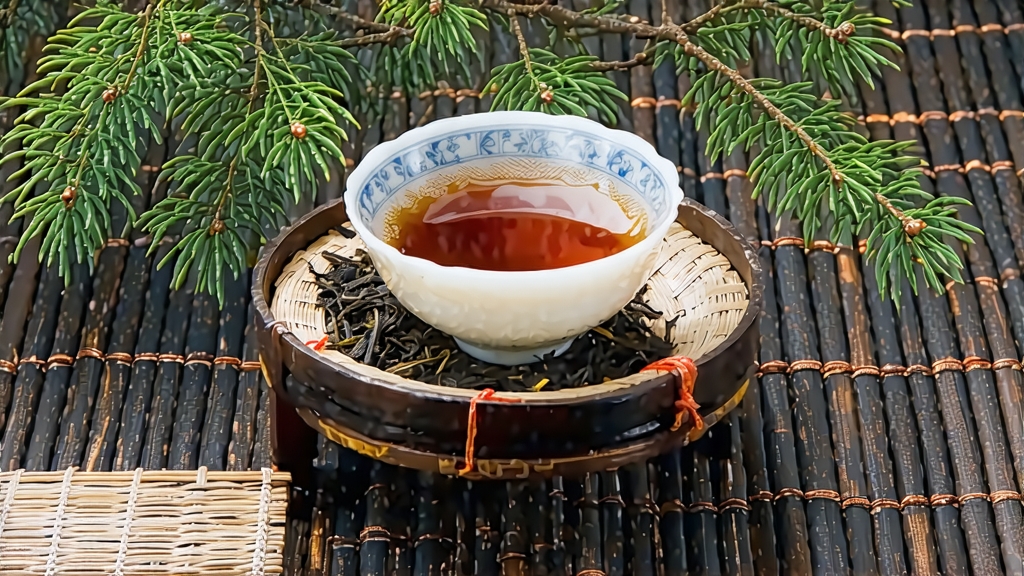
Long before English breakfast tables knew the malty kiss of Assam or the bright snap of Ceylon, a small leaf from the granite gorges of northern Fujian sailed out of the port of Xiamen under the label “Bohea Souchong.” That 17th-century cargo was Lapsang Souchong, the earliest deliberately crafted black tea in history and the prototype that taught the world how to oxidize leaf for depth, sweetness and shelf-life. Today the name still evokes polarized devotion: some recall a campfire in a cup, others a velvet-smoked liqueur that finishes with longan and honey. Both memories are authentic, because Lapsang is not a single recipe but a spectrum of terroir, smoke and skill.
Origin stories cluster around the Wuyi’s Tongmu Guan, a protected ravine where mist, pine and mineral soil conspire to slow the growth of the small-leaf Da Bai varietal. According to grower lore, Qing-era soldiers requisitioned a village drying shed mid-harvest; in haste to save the leaf, farmers dried it over fresh pine embers, and the accidental smoke proved marketable. Whether legend or marketing, the tale underlines two constants: the tea is born in a microclimate unreachable by modern roads, and its identity is inseparable from pine.
Geography grants the first signature. At 27° north, 600–1 200 m elevation, Tongmu’s narrow gorge funnels humid air upward, condensing into fog that filters sunlight to a soft, shifting amber. The soil is weathered granite veined with quartz; drainage is instant yet water is retained in fissures, forcing roots to mine minerals that translate into cup sweetness. Because night temperatures can drop 15 °C below daytime highs, the plant produces more amino acids, especially L-theanine, giving the tea its famous cocoa-like mellowness even before smoke is applied.
Crafting Lapsang is a dialogue between oxidation and aromatization. Picking begins in late April, standard is two leaves and a bud, plucked when the dew has lifted but before the sun wilts the edges. The leaf is first withered on bamboo screens set in the upper level of the three-story wooden factory; below, smouldering pine logs (Pinus massoniana) release cool, resinous smoke that drifts upward for 6–8 hours. This cold-smoke stage is crucial: too hot and the leaf bakes, locking in grassy notes; too cool and moisture remains, inviting mould. Masters gauge readiness by touch—leaf must feel like soft leather—then roll it gently to rupture cells without shredding. Oxidation follows in wooden trays lined with wet cloth; here the leaf darkens to a coppery mahogany while absorbing ambient smoke. When 85 % of the surface is oxidized, the tea is given a final “fire finish”: baskets are lowered to the ground floor where pine embers are hotter, 70–80 °C, driving residual moisture to 5 % and setting the smoky signature. The entire cycle takes 28–32 hours, after which the tea rests in linen-lined tins for at least one moon cycle so aromatics marry and sharp edges round.
Modern versions diverge along a smoke continuum. Traditional Tongmu Lapsang uses only local pine, no added flavouring; the cup is clean, with a cool menthol top note reminiscent of pine sap, a middle of dried longan and a cocoa-laced finish that lingers like fine cigar. “Zheng Shan” (literally “original mountain”) is the protected designation, limited to 6000 kg per year and rarely exported in bulk. Further down the valley, producers bake leaf in electric ovens then scent it with atomized liquid smoke; these versions dominate supermarket shelves, smelling like kippers and tasting bluntly tarry. A third style, “unsmoked Lapsang,” has emerged for the Chinese domestic market: same cultivar and oxidation, but dried over charcoal from lychee wood, yielding a tea that is malty and date-sweet with only a whisper of resin. Each style has its protocol; knowing which you hold decides leaf quantity, water temperature and steeping rhythm.
Gongfu infusion is the most reliable way to separate noble smoke from mere soot. Use a small 120 ml porcelain gaiwan or Zisha clay pot that has previously seasoned only black teas. Weigh 5 g of leaf—